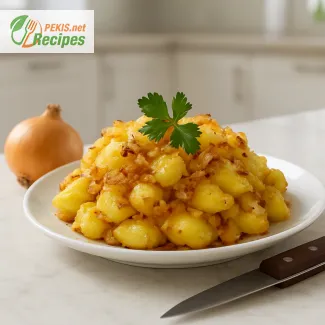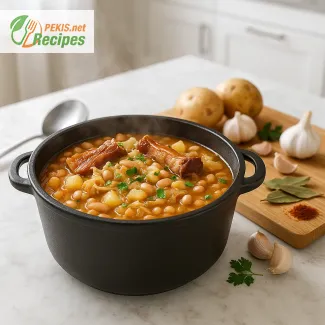Sarma serves 6 portions with a prep time of 30 minutes, cook time of 90 minutes, and a total of 120 minutes. Made with pickled cabbage leaves, ground pork and beef, rice, and slow-simmered in a rich tomato broth, these rolls deliver deep, comforting flavors. The dish is known for its tender texture, slight tang from the fermented cabbage, and hearty filling that improves even more after resting. It can be stored for 2 days at room temperature, 5 days in the fridge, or frozen for 2 months, making it perfect for both festive gatherings and meal prep.
PEKIS – professional chef and recipe developer with over 25 years of experience in cooking and baking, specialized in European and international cuisine. For this sarma recipe, I draw on years of exploring Balkan traditions, learning how families prepare their stuffed cabbage rolls for holidays and everyday comfort. My approach brings together the authentic flavors of fermented cabbage, slow-simmered meats, and carefully layered spices to recreate the warmth of this timeless dish.

Traditional Balkan Comfort Food with Layers of Flavor
The cultural heritage of stuffed cabbage rolls
Sarma, also known as stuffed cabbage rolls, represents one of the most beloved dishes in Balkan cuisine. Prepared with pickled or blanched cabbage leaves filled with a mixture of ground meat, rice, and carefully balanced spices, it embodies the idea of slow-cooked comfort food that brings families together. The dish is commonly served during festive gatherings, holidays, and Sunday family lunches, symbolizing abundance and hospitality. Its taste is rich, savory, and slightly tangy thanks to the fermented cabbage, making it stand apart from other European stuffed vegetable recipes.
The origins of sarma can be traced back to the Ottoman Empire, where variations of stuffed leaves, known as “dolma,” spread across the Balkans, Central Europe, and even parts of the Middle East. Over the centuries, each region developed its own signature preparation, but the Balkan version using cabbage leaves has become iconic. Today, sarma remains a centerpiece of traditional cooking in countries like Serbia, Bosnia, Croatia, North Macedonia, and Slovenia, with each household passing down its own cherished recipe.
What makes sarma unique compared to other dishes
Unlike many stuffed vegetable dishes, sarma carries a distinctive balance of sour cabbage, succulent filling, and long, gentle simmering that melds all flavors into one harmonious whole. The fermented leaves add a sharp edge that complements the richness of the meat and the softness of the rice. Slowly cooking the rolls in a clay pot or heavy casserole dish allows the juices from the cabbage, tomato paste, and smoked meats (often added for depth) to infuse into every bite.
Key characteristics that define authentic sarma include:
- Fermented cabbage leaves for tangy flavor and pliable wrapping.
- Ground pork, beef, or lamb mixed with rice for a hearty filling.
- Paprika, garlic, onions, and herbs to create warmth and aroma.
- Slow cooking in broth or tomato sauce for tender, melt-in-the-mouth texture.
Why you will love this recipe
- Rich, deep flavors that develop during slow cooking.
- Perfect comfort food for cold seasons and family gatherings.
- Versatile filling options to adapt to dietary preferences.
- A dish with cultural depth and timeless tradition.
- Freezer-friendly and ideal for preparing ahead of time.
Creative variations to explore
Sarma is highly adaptable, which makes it possible to experiment without losing its essence:
- Vegetarian sarma: Replace meat with mushrooms, lentils, or a mix of vegetables and grains.
- Spicy sarma: Add chili flakes or hot paprika for an extra kick.
- Mediterranean twist: Incorporate olive oil, fresh herbs like dill and parsley, and even feta cheese into the filling.
- Mini sarma bites: Create smaller rolls for party appetizers or tasting platters.
- Fusion sarma: Experiment with different wrappers like collard greens or kale for a modern version.
Storage and make-ahead tips
One of the great advantages of sarma is its ability to taste even better the next day, as the flavors continue to deepen. Proper storage ensures it remains safe and delicious:
- At room temperature, sarma can be kept for up to 2 days if covered.
- In the refrigerator, it stays fresh for about 5 days.
- For longer storage, it can be frozen for up to 2 months. When freezing, place the rolls in an airtight container with some cooking liquid to preserve moisture.
- To reheat, place the rolls in the oven at 150 °C (300 °F) for 8–10 minutes, or gently warm them on the stovetop in their sauce until heated through.
The role of ingredients in creating the perfect sarma
Every element in sarma has a distinct purpose that contributes to the harmony of the dish:
- Cabbage leaves: Provide structure and tanginess.
- Meat: Adds richness, depth, and satisfying texture.
- Rice: Balances the density of the filling and absorbs juices.
- Tomato paste or puree: Enhances color, acidity, and flavor complexity.
- Onions and garlic: Build a savory foundation.
- Paprika and herbs: Offer warmth, fragrance, and regional identity.
- Smoked meats or bacon (optional): Create a rustic and hearty undertone.
Sarma as a cultural entity and festive dish
In many Balkan households, sarma is not just food but a ritual of togetherness. Families often gather to prepare large pots of rolls before Christmas, New Year, or Easter, sharing the process across generations. The dish also bridges cultural boundaries, as similar recipes exist in Central Europe, where cabbage rolls are called “gołąbki” in Poland, “kåldolmar” in Sweden, and “holubtsi” in Ukraine. Yet, the Balkan sarma stands out for its characteristic fermented cabbage, which gives it a uniquely robust flavor profile.
This interplay of history, tradition, and flavor makes sarma more than a simple meal – it is a culinary story passed down through centuries, carrying the essence of the Balkans to every table where it is served.
- Rinse the pickled cabbage leaves in cold water to reduce excess salt and acidity. Trim the thick veins for easier rolling.
- In a large bowl, mix ground pork, ground beef, rice, onion, garlic, paprika powder, salt, and black pepper until combined.
- Place a spoonful of filling onto each cabbage leaf and fold the sides, rolling tightly to form compact rolls.
- In a heavy casserole or pot, layer a few cabbage leaves on the bottom to prevent sticking.
- Arrange the rolls seam side down, placing them close together. Add diced smoked bacon between layers if using.
- Mix tomato paste with water or broth and pour over the rolls until almost covered. Add bay leaves.
- Cover the pot with remaining cabbage leaves and a lid. Simmer gently on low heat for 90 minutes until tender.
- Remove from heat, discard bay leaves, and let the dish rest for 15 minutes before serving.
- Serve hot with sour cream (for serving).
FAQ questionWhat cabbage should I use for sarma?
Use fermented (pickled) cabbage leaves for the classic Balkan flavor. They’re pliable, slightly tangy, and wrap tightly without tearing. If your leaves are very salty or acidic, rinse them in cold water and, if needed, soak for 10–15 minutes to tame the brine while keeping that signature sour note.
FAQ questionCan I make sarma with one type of meat only?
Yes. While many families blend ground pork and beef for depth, you can go all-beef for a cleaner taste or all-pork for richness. Keep the balance by preserving the meat-to-rice ratio and seasoning with paprika, onion, and garlic so the filling stays juicy and aromatic.
FAQ questionWhy add uncooked rice to the filling?
Uncooked rice absorbs juices as the rolls slow-simmer, binding the filling without turning mushy. It expands gently, helping each roll stay plump and tender. Parboiled rice is also fine if you prefer grains that hold shape; just reduce liquid slightly to maintain the sauce body.
FAQ questionHow do I stop the rolls from unraveling while cooking?
Trim thick veins so leaves fold easily, tuck the sides in tightly, and place rolls seam-side down. Line the pot base with extra cabbage leaves to prevent sticking and top with a protective layer. A slow, gentle simmer (not a hard boil) keeps the structure intact and the texture melt-in-the-mouth.
FAQ questionCan I make sarma ahead and freeze it?
Absolutely. Sarma holds beautifully: room temperature 2 days, refrigerated 5 days, frozen 2 months. Freeze in portions with some cooking liquid to lock in moisture. Reheat covered at 150 °C (300 °F) for 8–10 minutes or on the stovetop, letting the sauce re-emulsify for that deep, rounded flavor.
FAQ questionWhat can I serve with sarma?
Classic pairings include mashed potatoes, crusty bread, or a dollop of sour cream for coolness against the savory, tangy rolls. For freshness, add simple cucumber or cabbage salad, and if you like smoke, serve with a side of smoked sausage or bacon bits for extra umami.
FAQ questionHow do I adjust sourness and salt without losing character?
If the cabbage is intense, rinse and briefly soak the leaves, then season the filling slightly under and finish salting in the sauce. A spoon of tomato paste balances acidity with gentle sweetness, while bay leaf and paprika layer warmth so the final taste is bright yet rounded.
Sarma brings together the essence of Balkan comfort food, blending the sharp tang of fermented cabbage leaves with the richness of meat and rice. Its strength lies in the slow cooking process, where every ingredient gently merges into a dish that is hearty, flavorful, and deeply satisfying. More than a meal, it is a tradition that unites generations around the table.
The balance of savory filling, aromatic spices, and long simmering makes sarma stand apart from other stuffed cabbage rolls. Each bite carries the warmth of paprika, garlic, and onion, softened by the tender cabbage that holds everything together. This harmony of textures and flavors transforms simple ingredients into a comforting classic with timeless appeal.
Its adaptability allows it to suit many occasions, from festive celebrations to everyday family dinners. The rolls are easy to store, with flavors improving as they rest, and they reheat beautifully, making sarma both practical and delicious. It is a dish that rewards patience, offering layers of depth that unfold with every mouthful.
Sarma also holds cultural significance, connecting culinary traditions across the Balkans and beyond. It symbolizes sharing, heritage, and hospitality, ensuring it remains not only a recipe but a story passed down. This lasting legacy makes sarma a dish worth revisiting, one that combines history, flavor, and the simple joy of food prepared with care.
Allergens present in the recipe:
- Gluten: may be present in some rice brands or tomato paste additives.
- Dairy: sour cream (for serving).
Tips for allergen-free preparation:
- Replace sour cream with lactose-free cream or plant-based alternatives (soy or oat-based).
- Use certified gluten-free rice and tomato paste to avoid gluten traces.
- Vitamin C: 24 mg – supports immune system and collagen production.
- Vitamin B6: 0.6 mg – essential for metabolism and brain health.
- Iron: 4.5 mg – contributes to oxygen transport in the blood.
- Potassium: 780 mg – helps regulate fluid balance and muscle contractions.
- Magnesium: 45 mg – supports muscle and nerve function.
- Zinc: 5 mg – boosts immune defense and wound healing.
- Lycopene: 3.8 mg – from tomato paste, protective for heart and skin health.
- Beta-carotene: 1.2 mg – supports eye health and reduces oxidative stress.
- Polyphenols: 120 mg – from cabbage and onion, linked to reduced inflammation.





